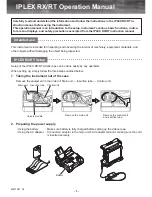
CSA8000B & TDS8000B User Manual
3- 101
Creating Math Waveforms
Once you have acquired waveforms or taken measurements on waveforms, the
instrument can mathematically combine them to create a waveform that supports
your data-analysis task. For example, you can define a math waveform that
combines waveforms mathematically (+, --, /, x). You can also integrate a single
waveform into an integral math waveform as is shown below.
Source waveform
Math waveform
Defining Math Waveforms
This instrument supports mathematical combination and functional transforma-
tions of waveforms that it acquires. Figure 3--24 shows this concept:
Channel waveform
(C2)
Math waveform
(M1)
Diff(C2)
Math expression
(function(source))
Figure 3- 24: Functional transformation of an acquired waveform
Summary of Contents for CSA8000B Series
Page 4: ......
Page 18: ...Preface xiv CSA8000B TDS8000B User Manual ...
Page 26: ...Check the Package Contents 1 8 CSA8000B TDS8000B User Manual ...
Page 62: ...Accessories and Options 1 44 CSA8000B TDS8000B User Manual ...
Page 76: ...Overview 3 2 CSA8000B TDS8000B User Manual ...
Page 112: ...Acquiring Waveforms 3 38 CSA8000B TDS8000B User Manual ...
Page 126: ...Triggering 3 52 CSA8000B TDS8000B User Manual ...
Page 146: ...Displaying Waveforms 3 72 CSA8000B TDS8000B User Manual ...
Page 174: ...Measuring Waveforms 3 100 CSA8000B TDS8000B User Manual ...
Page 186: ...Creating Math Waveforms 3 112 CSA8000B TDS8000B User Manual ...
Page 214: ...Data Input and Output 3 140 CSA8000B TDS8000B User Manual ...
Page 353: ......
Page 354: ......
















































